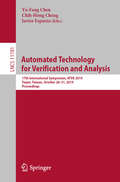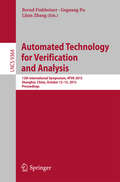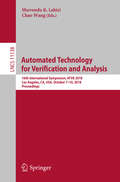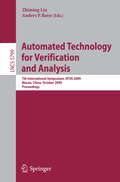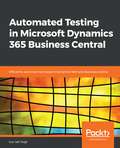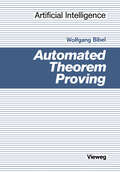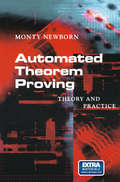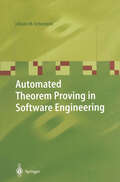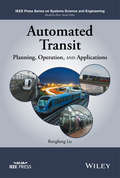- Table View
- List View
Automated Technology for Verification and Analysis: 17th International Symposium, ATVA 2019, Taipei, Taiwan, October 28–31, 2019, Proceedings (Lecture Notes in Computer Science #11781)
by Yu-Fang Chen Chih-Hong Cheng Javier EsparzaThis book constitutes the refereed proceedings of the 17th International Symposium on Automated Technology for Verification and Analysis, ATVA 2019, held in Taipei, Taiwan in October 2019.The 24 regular papers presented together with 3 tool papers were carefully reviewed and selected from 65 submissions. The symposium is dedicated to the promotion of research on theoretical and practical aspects of automated analysis, verification and synthesis by providing a forum for interaction between the regional and the international research communities and industry in the field. The papers focus on cyber-physical systems; runtime techniques; testing; automata; synthesis; stochastic systems and model checking.
Automated Technology for Verification and Analysis: 15th International Symposium, ATVA 2017, Pune, India, October 3–6, 2017, Proceedings (Lecture Notes in Computer Science #10482)
by Deepak D'Souza K. Narayan KumarThis book constitutes the refereed proceedings of the 15th International Symposium on Automated Technology for Verification and Analysis, ATVA 2017, held in Pune, India, in October 2017. The 22 full and 7 short papers presented in this volume were carefully reviewed and selected from 78 submissions. The book also contains one invited talk in full-paper length. The contributions are organized in topical sections named: program analysis; model checking and temporal logics; neural networks; learning and invariant synthesis; and hybrid systems and control.
Automated Technology for Verification and Analysis: 13th International Symposium, ATVA 2015, Shanghai, China, October 12-15, 2015, Proceedings (Lecture Notes in Computer Science #9364)
by Bernd Finkbeiner Geguang Pu Lijun ZhangThis book constitutes the proceedings of the 13th International Symposium on Automated Technology for Verification and Analysis, ATVA 2015, held in Shanghai, China, in October 2015. The 27 revised papers presented together with 6 tool papers in this volume were carefully reviewed and selected from 95 submissions. They show current research on theoretical and practical aspects of automated analysis, verification and synthesis by providing an international forum for interaction among the researchers in academia and industry.
Automated Technology for Verification and Analysis: 4th International Symposium, ATVA 2006, Beijing, China, October 23-26, 2006, Proceedings (Lecture Notes in Computer Science #4218)
by Susanne Graf Wenhui ZhangThis book constitutes the refereed proceedings of the Third International Symposium on Automated Technology for Verification and Analysis, ATVA 2006, held in Beijing, China in October 2006. The 35 revised full papers presented together with abstracts of three keynote papers were carefully reviewed and selected from 137 submissions.
Automated Technology for Verification and Analysis: 19th International Symposium, ATVA 2021, Gold Coast, QLD, Australia, October 18–22, 2021, Proceedings (Lecture Notes in Computer Science #12971)
by Zhe Hou Vijay GaneshThis book constitutes the refereed proceedings of the 19th International Symposium on Automated Technology for Verification and Analysis, ATVA 2021, held in Gold Coast, Australia in October 2021. The symposium is dedicated to promoting research in theoretical and practical aspects of automated analysis, verification and synthesis by providing an international venue for the researchers to present new results. The 19 regular papers presented together with 4 tool papers and 1 invited paper were carefully reviewed and selected from 75 submissions. The papers are divided into the following topical sub-headings: Automata Theory; Machine learning for Formal Methods; Theorem Proving and Tools; Model Checking; Probabilistic Analysis; Software and Hardware Verification; System Synthesis and Approximation; and Verification of Machine Learning.
Automated Technology for Verification and Analysis: 11th International Symposium, ATVA 2013, Hanoi, Vietnam, October 15-18, 2013, Proceedings (Lecture Notes in Computer Science #8172)
by Dang Van Hung Mizuhito OgawaThis book constitutes the refereed proceedings of the 11th International Symposium on Automated Technology for Verification and Analysis, ATVA 2013, held at Hanoi, Vietnam, in October 2013. The 27 regular papers, 3 short papers and 12 tool papers presented together with 3 invited talks were carefully selected from73 submissions. The papers are organized in topical, sections on analysis and verification of hardware circuits, systems-on-chip and embedded systems, analysis of real-time, hybrid, priced/weighted and probabilistic systems, deductive, algorithmic, compositional, and abstraction/refinement techniques for analysis and verification, analytical techniques for safety, security, and dependability, testing and runtime analysis based on verification technology, analysis and verification of parallel and concurrent hardware/software systems, verification in industrial practice, and applications and case studies.
Automated Technology for Verification and Analysis: 18th International Symposium, ATVA 2020, Hanoi, Vietnam, October 19–23, 2020, Proceedings (Lecture Notes in Computer Science #12302)
by Dang Van Hung Oleg SokolskyThis book constitutes the refereed proceedings of the 18th International Symposium on Automated Technology for Verification and Analysis, ATVA 2020, held in Hanoi, Vietnam, in October 2020. The 27 regular papers presented together with 5 tool papers and 2 invited papers were carefully reviewed and selected from 75 submissions. The symposium is dedicated to promoting research in theoretical and practical aspects of automated analysis, verification and synthesis by providing an international venue for the researchers to present new results. The papers focus on neural networks and machine learning; automata; logics; techniques for verification, analysis and testing; model checking and decision procedures; synthesis; and randomization and probabilistic systems.
Automated Technology for Verification and Analysis: 16th International Symposium, ATVA 2018, Los Angeles, CA, USA, October 7-10, 2018, Proceedings (Lecture Notes in Computer Science #11138)
by Shuvendu K. Lahiri Chao WangThis book constitutes the refereed proceedings of the 24th International Symposium on Automated Technology for Verification and Analysis, ATVA 2018, held in Los Angeles, CA, USA in October 2018.The 27 full papers presented together with 5 short papers and 3 invited talks were carefully reviewed and selected from 82 submissions. The symposium is dedicated to the promotion of research on theoretical and practical aspects of automated analysis, verification and synthesis by providing a forum for interaction between the regional and the international research communities and industry in the field.
Automated Technology for Verification and Analysis: 7th International Symposium, ATVA 2009, Macao, China, October 14-16, 2009, Proceedings (Lecture Notes in Computer Science #5799)
by Zhiming Liu Anders P. RavnThis book constitutes the proceedings of the 7th International Symposium on Automated Technology for Verification and Analysis, ATVA 2009, held in Macao, China, in October 2009. The 23 regular papers and 3 took papers presented together with 3 invited talks, were carefully reviewed and selected from 74 research papers and 10 tool papers submissions. The papers are organized in topical sections on state space reduction, tools, probabilistic systems, medley, temporal logic, abstraction and refinement, and fault tolerant systems.
Automated Technology for Verification and Analysis: 10th International Symposium, ATVA 2012, Thiruvananthapuram, India, October 3-6, 2012, Proceedings (Lecture Notes in Computer Science #7561)
by Madhavan Mukund Supratik ChakrabortyThis book constitutes the thoroughly refereed proceedings of the 10th International Symposium on Automated Technology for Verification and Analysis, ATVA 2012, held at Thiruvananthapuram, Kerala, India, in October 2012. The 25 regular papers, 3 invited papers and 4 tool papers presented were carefully selected from numerous submissions. Conference papers are organized in 9 technical sessions, covering the topics of automata theory, logics and proofs, model checking, software verification, synthesis, verification and parallelism, probabilistic verification, constraint solving and applications, and probabilistic systems.
Automated Technology for Verification and Analysis: 5th International Symposium, ATVA 2007 Tokyo, Japan, October 22-25, 2007 Proceedings (Lecture Notes in Computer Science #4762)
by Kedar Namjoshi Tomohiro Yoneda Teruo Higashino Yoshio OkamuraThis book constitutes the refereed proceedings of the 5th International Symposium on Automated Technology for Verification and Analysis, ATVA 2007. The 29 revised full papers presented together with seven short papers address theoretical methods to achieve correct software or hardware systems, including both functional and non functional aspects; as well as applications of theory in engineering methods and particular domains and handling of practical problems occurring in tools.
Automated Technology for Verification and Analysis: Third International Symposium, ATVA 2005, Taipei, Taiwan, October 4-7, 2005, Proceedings (Lecture Notes in Computer Science #3707)
by Doron A. Peled Yih-Kuen TsayThe Automated Technology for Veri?cation and Analysis (ATVA) international symposium series was initiated in 2003, responding to a growing interest in formal veri?cation spurred by the booming IT industry, particularly hardware design and manufacturing in East Asia. Its purpose is to promote research on automated veri?cation and analysis in the region by providing a forum for int- action between the regional and the international research/industrial commu- ties of the ?eld. ATVA 2005, the third of the ATVA series, was held in Taipei, Taiwan, October 4–7, 2005. The main theme of the symposium encompasses - sign, complexities, tools, and applications of automated methods for veri?cation and analysis. The symposium was co-located and had a two-day overlap with FORTE 2005, which was held October 2–5, 2005. We received a total of 95 submissions from 17 countries. Each submission was assigned to three Program Committee members, who were helped by their subreviewers, for rigorous and fair evaluation. The ?nal deliberation by the P- gram Committee was conducted over email for a duration of about 10 days after nearly all review reports had been collected. In the end, 33 papers were - lectedforinclusionintheprogram.ATVA2005hadthreekeynotespeechesgiven respectively by Amir Pnueli (joint with FORTE 2005), Zohar Manna, and Wo- gang Thomas. The main symposium was preceded by a tutorial day, consisting of three two-hour lectures given also by the keynote speakers.
Automated Technology for Verification and Analysis: Second International Conference, ATVA 2004, Taipei, Taiwan, ROC, October 31 - November 3, 2004. Proceedings (Lecture Notes in Computer Science #3299)
by Farn WangAutomated Testing in Microsoft Dynamics 365 Business Central: Efficiently Automate Test Cases In Dynamics Nav And Business Central
by Luc Van VugtDynamics 365 Business Central is the new Cloud-based SaaS ERP proposition from Microsoft. It’s not as simple as it used to be way back when it was called Navigator, Navision Financials, or Microsoft Business Solutions-Navision. Our development practices are becoming more formal, and with this the call for test automation is pressing on us. This book will teach you to leverage testing tools available with Dynamics 365 Business Central to perform automated testing.
Automated Testing In Microsoft Dynamics 365 Business Central: Efficiently Automate Test Cases For Faster Development Cycles With Less Time Needed For Manual Testing
by Luc Van VugtEfficiently automate test cases for faster development cycles with less time needed for manual testing
Automated Theorem Proving (Künstliche Intelligenz)
by Wolfgang BibelSince both the coments and the structure of the book appeared to be successful, only minor changes were made. In particular, some recent work in ATP has been incorporated so that the book continues to reflect the state of the art in the field. The most significant change is in the quality of the layout including the removal of a number of inaccuracies and typing errors. R. Caferra, E. Eder, F. van der Linden, and J. Muller have caught vanous minor errors. P. Haddawy and S.T. Pope have provided many stilistic improvements of the English text. Last not least, A. Bentrup and W. Fischer have produced the beautiful layout. The extensive work of typesetting was financally supported within ESPRIT pro ject 415. Munchen, September 1986 W. Bibel PREFACE Among the dreams of mankind is the one dealing with the mechanization of human thought. As the world today has become so complex that humans apparently fail to manage it properly with their intellectual gifts, the realization of this dream might be regarded even as something like a necessity. On the other hand, the incredi ble advances in computer technology let it appear as a real possibility.
Automated Theorem Proving: Theory and Practice
by Monty NewbornThis text and software package introduces readers to automated theorem proving, while providing two approaches implemented as easy-to-use programs. These are semantic-tree theorem proving and resolution-refutation theorem proving. The early chapters introduce first-order predicate calculus, well-formed formulae, and their transformation to clauses. Then the author goes on to show how the two methods work and provides numerous examples for readers to try their hand at theorem-proving experiments. Each chapter comes with exercises designed to familiarise the readers with the ideas and with the software, and answers to many of the problems.
Automated Theorem Proving in Software Engineering
by Johann M. SchumannGrowing demands for the quality, safety, and security of software can only be satisfied by the rigorous application of formal methods during software design. This book methodically investigates the potential of first-order logic automated theorem provers for applications in software engineering. Illustrated by complete case studies on protocol verification, verification of security protocols, and logic-based software reuse, this book provides techniques for assessing the prover's capabilities and for selecting and developing an appropriate interface architecture.
Automated Theorem Proving: A Logical Basis (Fundamental Studies in Computer Science #1)
by D.W. LovelandAutomated Theorem Proving: A Logical Basis
Automated Theory Formation in Pure Mathematics (Distinguished Dissertations)
by Simon ColtonIn recent years, Artificial Intelligence researchers have largely focused their efforts on solving specific problems, with less emphasis on 'the big picture' - automating large scale tasks which require human-level intelligence to undertake. The subject of this book, automated theory formation in mathematics, is such a large scale task. Automated theory formation requires the invention of new concepts, the calculating of examples, the making of conjectures and the proving of theorems. This book, representing four years of PhD work by Dr. Simon Colton demonstrates how theory formation can be automated. Building on over 20 years of research into constructing an automated mathematician carried out in Professor Alan Bundy's mathematical reasoning group in Edinburgh, Dr. Colton has implemented the HR system as a solution to the problem of forming theories by computer. HR uses various pieces of mathematical software, including automated theorem provers, model generators and databases, to build a theory from the bare minimum of information - the axioms of a domain. The main application of this work has been mathematical discovery, and HR has had many successes. In particular, it has invented 20 new types of number of sufficient interest to be accepted into the Encyclopaedia of Integer Sequences, a repository of over 60,000 sequences contributed by many (human) mathematicians.
Automated Trading with R: Quantitative Research and Platform Development
by Chris ConlanLearn to trade algorithmically with your existing brokerage, from data management, to strategy optimization, to order execution, using free and publicly available data. Connect to your brokerage’s API, and the source code is plug-and-play.Automated Trading with R explains automated trading, starting with its mathematics and moving to its computation and execution. You will gain a unique insight into the mechanics and computational considerations taken in building a back-tester, strategy optimizer, and fully functional trading platform.The platform built in this book can serve as a complete replacement for commercially available platforms used by retail traders and small funds. Software components are strictly decoupled and easily scalable, providing opportunity to substitute any data source, trading algorithm, or brokerage. This book will:Provide a flexible alternative to common strategy automation frameworks, like Tradestation, Metatrader, and CQG, to small funds and retail tradersOffer an understanding of the internal mechanisms of an automated trading systemStandardize discussion and notation of real-world strategy optimization problemsWhat You Will LearnUnderstand machine-learning criteria for statistical validity in the context of time-seriesOptimize strategies, generate real-time trading decisions, and minimize computation time while programming an automated strategy in R and using its package libraryBest simulate strategy performance in its specific use case to derive accurate performance estimatesUnderstand critical real-world variables pertaining to portfolio management and performance assessment, including latency, drawdowns, varying trade size, portfolio growth, and penalization of unused capitalWho This Book Is ForTraders/practitioners at the retail or small fund level with at least an undergraduate background in finance or computer science; graduate level finance or data science students
Automated Transit: Planning, Operation, and Applications (IEEE Press Series on Systems Science and Engineering)
by Rongfang LiuA comprehensive discussion of automated transit This book analyzes the successful implementations of automated transit in various international locations, such as Paris, Toronto, London, and Kuala Lumpur, and investigates the apparent lack of automated transit applications in the urban environment in the United States. The book begins with a brief definition of automated transit and its historical development. After a thorough description of the technical specifications, the author highlights a few applications from each sub-group of the automated transit spectrum. International case studies display various technologies and their applications, and identify vital factors that affect each system and performance evaluations of existing applications. The book then discusses the planning and operation of automated transit applications at both macro and micro levels. Finally, the book covers a number of less successful concepts, as well as the lessons learned, allowing readers to gain a comprehensive understanding of the topic. Key features: Provides a thorough examination of automated transit applications, their impact and implications for society Written by the committee chair for the Automated Transit Systems Transportation, Research Board Offers essential information on planning, costs, and applications of automated transit systems Covers driverless metros, automated LRT, group and personal rapid transit, a review of worldwide applications Includes capacity and safety guidelines, as well as vehicles, propulsion, and communication and control systems This book is essential reading for engineers, researchers, scientists, college or graduate students who work in transportation planning, engineering, operation and management fields.
Automated Transit: Planning, Operation, and Applications (IEEE Press Series on Systems Science and Engineering)
by Rongfang LiuA comprehensive discussion of automated transit This book analyzes the successful implementations of automated transit in various international locations, such as Paris, Toronto, London, and Kuala Lumpur, and investigates the apparent lack of automated transit applications in the urban environment in the United States. The book begins with a brief definition of automated transit and its historical development. After a thorough description of the technical specifications, the author highlights a few applications from each sub-group of the automated transit spectrum. International case studies display various technologies and their applications, and identify vital factors that affect each system and performance evaluations of existing applications. The book then discusses the planning and operation of automated transit applications at both macro and micro levels. Finally, the book covers a number of less successful concepts, as well as the lessons learned, allowing readers to gain a comprehensive understanding of the topic. Key features: Provides a thorough examination of automated transit applications, their impact and implications for society Written by the committee chair for the Automated Transit Systems Transportation, Research Board Offers essential information on planning, costs, and applications of automated transit systems Covers driverless metros, automated LRT, group and personal rapid transit, a review of worldwide applications Includes capacity and safety guidelines, as well as vehicles, propulsion, and communication and control systems This book is essential reading for engineers, researchers, scientists, college or graduate students who work in transportation planning, engineering, operation and management fields.
Automated Unit Testing with ABAP: A Practical Approach
by James E. McDonoughWrite automated unit tests for the ABAP language. This book teaches programmers using simple examples and metaphors and explains the underlying concepts of writing effective automated unit tests. Many, if not most, ABAP programmers learned their programming and testing skills before the ABAP development environment provided an automated unit testing facility. Automated Unit Testing with ABAP: A Practical Approach offers hope and salvation to ABAP programmers who continue to toil with antiquated manual unit testing processes, taking them by the hand and lifting them out of that dungeon of despair with a modern and proven alternative. It begins by explaining how the xUnit family of automated testing frameworks provides a quick and effective means of insuring high-quality software. It then focuses on the ABAP Unit Testing Facility, the xUnit framework applicable specifically to the ABAP language, showing how it can be used to bring ABAP applications under automated testing control, from old legacy applications to those newly written.Whereas xUnit testing has been widely accepted with developers writing in many other programming languages, it is an unfortunate fact in the ABAP community that many programmers still are unfamiliar with xUnit concepts and do not know how to begin implementing automated unit testing into their development process. This book demonstrates how to refactor programs so they become designed for testability, showing how to use process encapsulation and test isolation to facilitate automated testing, including a thorough explanation of test-driven development and the use of test doubles. The book: Shows how to write automated unit tests for ABAPInstills ABAP programmers with the confidence to refactor poorly written codeExplains how an automated testing harness facilitates rapid software developmentTeaches how to utilize test-driven development (TDD) with ABAPOffers advice and tips on the best ways to write automated unit tests What You Will Learn Become familiar with the xUnit approach to testingKnow the ABAP statements that interfere with running automated unit tests and how to accommodate themUnderstand what it means to isolate code for testing and how this is achievedGain the confidence to refactor poorly written codeMake ABAP programs designed for testabilityReap the benefits of spending less time manually unit testing ABAP programsUse test-driven development (TDD) with ABAP programmingUse configurable test doubles in ABAP Who This Book Is ForABAP programmers who remain unfamiliar with the automated unit testing facility and those who already use it but want to improve their skill writing and using automated tests. The book addresses the reluctance and trepidation felt by procedural ABAP programmers who need to know some object-oriented concepts to use this facility, expands their horizons, and helps them step through the doorway leading to a different approach to program design.
